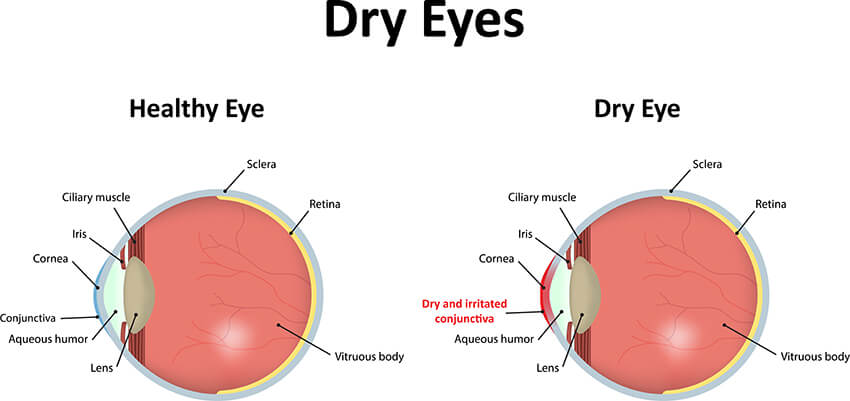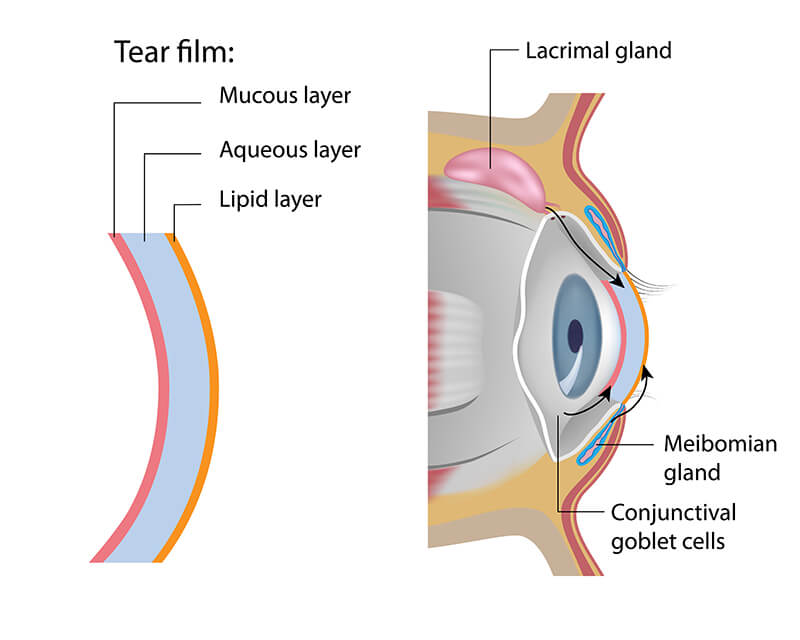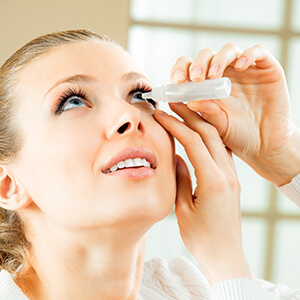What is Dry Eye?
Dry eye occurs when the quantity and/or quality of tears does not keep the surface of the eye (cornea) adequately lubricated. Millions of Americans suffer from dry eye to some degree, especially people over 50 and especially people who sit in front of a computer or who read all day.

What is Dry Eye Syndrome
Dry eye syndrome is a collection of symptoms caused by inadequate lubrication of the cornea. Symptoms can include blurry vision that comes and goes with a blink, a foreign body sensation, burning, itching, stinging, and general discomfort in the eye.
Each time you blink, tears spread across the cornea, the eye’s surface, wetting it to keep it smooth and clear and to promote good eye sight., and supplying nutrients for its health. Tears also wash away dust and debris, supply nutrients to the cornea, and contain antibodies to help prevent infection.
Without the correct amount and consistency of tears, the corneal surface can become irregular and vision blurry. In extreme cases, ulcers and scarring can occur, permanently affecting the health of the eye.
What are tears
Tears consist of three parts, like a water sandwich, and each of the three must function optimally to avoid dry eye disease.
The part closest to the cornea is the mucous layer, produced by goblet cells in the conjunctiva, the thin layer covering the white of the eye. The middle layer of our “sandwich” is the watery part produced by the lacrimal and accessory lacrimal glands.
The outer part, furthest from the cornea, is the oily part, produced by Meibomian glands that line the upper and lower eyelids and that discharge the oil through “pores” along the edge of the lid near the eyelashes. There are about 20-30 Meibomian oil glands in each eyelid.

Types of Dry Eye
There are two main types of dry eye:
- Water or aqueous deficiency occurs when the lacrimal glands do not produce enough of the watery part of the tears.
- Oil deficiency or Meibomian Gland Dysfunction (MGD) occurs when the outer oily layer of tears is deficient and tears evaporate almost as soon as you make them. This type of dry eye syndrome is also called “evaporative dry eye syndrome” since tears evaporate faster than they can be replaced.
Causes of dry eye
- Age and gender are the most common causes, since patients, especially women, and especially women over 50, tend to produce fewer tears.
- Diseases of the eyelid, such as blepharitis and Meibomian Gland Dysfunction can allow tears to evaporate too quickly.
- Systemic diseases such as Parkinson’s, lupus, Sjogren’s Syndrome, and rheumatoid arthritis can be associated with dry eye.
- Dry eyes can be caused by certain medications, such as tranquilizers and those for high blood pressure.
- Contact lens wear can cause dry eye, especially with weekly or monthly lenses that may become coated despite cleaning and disinfecting. A coated lens can prevent oxygen and nutrients from circulating under the lens, causing discomfort and dry eye. At Eastside Eye Associates we recommend a daily disposable lens whenever possible. Switching to a daily disposable lens can often alleviate dry eye symptoms.
- Exposure is another common cause of dry eye. In about 10% of the population, eyes may open slightly during sleep, causing dry eye symptoms before you even start your day. A gel artificial tear preparation at bedtime may be helpful.
How is dry eye treated?
 Depending on the causes of dry eye, we may use various approaches to relieve the symptoms. The mainstay of treatment of dry eyes is the lubrication of the cornea, either with artificial tears, gels, or ointments
Depending on the causes of dry eye, we may use various approaches to relieve the symptoms. The mainstay of treatment of dry eyes is the lubrication of the cornea, either with artificial tears, gels, or ointments
The first priority is to determine if a disease is the underlying cause of the dry eye (such as Sjögren’s syndrome or lacrimal and meibomian gland dysfunction).
If it is, then the underlying disease needs to be treated. In most cases, symptomatic relief with over-the-counter artificial tears, gels, or ointments may be enough to reduce symptoms.
Cyclosporine, an anti-inflammatory medication, is the only prescription drug available to treat dry eye. It increases basic tear production, decreases corneal damage, and reduces symptoms of dry eye.
It may take three to six months of a twice-a-day dosage for the medication to work, and in some cases, a short-term course of corticosteroid eye drops may also be required.
Whatever the cause of your dry eye symptoms, an eye examination at Eastside Eye Associates can usually uncover the cause, and successful treatment can be started.
Another option is to plug the punctum, a small drainage hole at the inner corners of the eyelids where tears drain from the eye into the nose. Lacrimal plugs, also called punctal plugs, can be inserted painlessly during a regular eye examination.
Some plugs, made of collagen, dissolve, and give temporary relief, while other plugs, made of silicone, give more long-lasting relief and in some cases may be left in permanently.
In some patients with dry eye, nutritional supplements of omega-3 fatty acids (especially DHA and EPA) may decrease symptoms of irritation.
In severe cases wearing a bandage soft contact lens for one or two days may greatly alleviate symptoms. We can discuss this and other treatments during an office visit.





